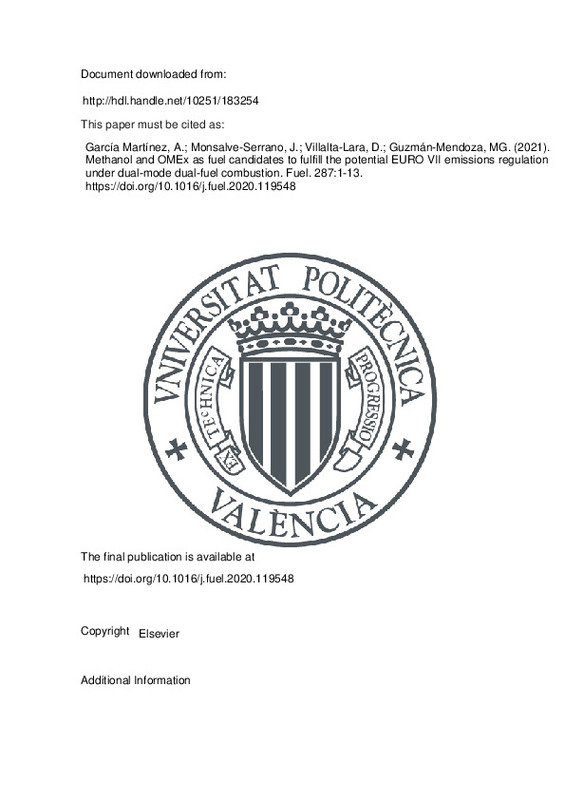JavaScript is disabled for your browser. Some features of this site may not work without it.
Buscar en RiuNet
Listar
Mi cuenta
Estadísticas
Ayuda RiuNet
Admin. UPV
Methanol and OMEx as fuel candidates to fulfill the potential EURO VII emissions regulation under dual-mode dual-fuel combustion
Mostrar el registro sencillo del ítem
Ficheros en el ítem
| dc.contributor.author | García Martínez, Antonio
|
es_ES |
| dc.contributor.author | Monsalve-Serrano, Javier
|
es_ES |
| dc.contributor.author | Villalta-Lara, David
|
es_ES |
| dc.contributor.author | Guzmán-Mendoza, María Gabriela
|
es_ES |
| dc.date.accessioned | 2022-06-13T18:05:16Z | |
| dc.date.available | 2022-06-13T18:05:16Z | |
| dc.date.issued | 2021-03-01 | es_ES |
| dc.identifier.issn | 0016-2361 | es_ES |
| dc.identifier.uri | http://hdl.handle.net/10251/183254 | |
| dc.description.abstract | [EN] Recent investigations show that there are different combustion strategies that promise to achieve higher efficiencies in internal combustion engines. Advanced combustion modes such as reactivity controlled compression ignition (RCCI) and dual-mode dual-fuel (DMDF) have proven to be able to achieve low NOx and soot engine-out emissions while being able to operate over the complete engine map. On another front, intensive research has been done in the fuels field. Oxygenated fuels, like oxymethylene dimethyl ethers (OMEx) and methanol, are of special interest because of their potential to reduce the soot emissions, while allowing to adjust parameters, such as EGR, to higher values to also reduce NOx emissions and avoid other problems like excessive in-cylinder peaks of pressure. In this research, the effects of diesel-methanol and OMEx-gasoline fuels were studied on a dual-mode dual-fuel (DFDM) multi-cylinder engine at 1800 rpm for various loads (25, 50, 80 and 100%). To do so, a dedicated calibration to optimize the brake thermal efficiency while trying to maintain NOx and soot emissions under EURO VI limitations was applied. Then, the combustion characteristics, performance and emissions results are compared to a base diesel-gasoline case. Boundary conditions (intake pressure, temperature and air mass) for each fuel combination where similar, with the exception of the premixed energy ratio, which was on average 20% lower for diesel-methanol. Each fuel combination was, weighted against each other by means of an merit function, where the fuel combination with the lowest value has the closest approximation to ideal BSFCeq, BSNOx, BSSoot, BSCO and BSHC targets. Results show that diesel-methanol presents no significant differences with respect to diesel-gasoline in terms of equivalent BSFCeq and NOx, while the substitution of diesel by OMEx in the dual-mode dual-fuel combustion has the potential of, although penalizing HC and CO emissions, not only achieving the EURO VI NOx (0.4 g/kWh) limits but also the future potential EURO VII (0.2 g/kWh) as well because of a negligible soot production that allows using EGR levels of up to 50%. | es_ES |
| dc.description.sponsorship | The authors thanks ARAMCO Overseas Company and VOLVO Group Trucks Technology for supporting this research. The authors acknowledge FEDER and Spanish Ministerio de Economia y Competitividad for partially supporting this research through TRANCO project (TRA201787694-R). The authors also acknowledge the Universitat Politecnica de Val`encia for partially supporting this research through Convocatoria de ayudas a Primeros Proyectos de Investigacion (PAID-06-18). | es_ES |
| dc.language | Inglés | es_ES |
| dc.publisher | Elsevier | es_ES |
| dc.relation.ispartof | Fuel | es_ES |
| dc.rights | Reconocimiento - No comercial - Sin obra derivada (by-nc-nd) | es_ES |
| dc.subject | Dual fuel combustion | es_ES |
| dc.subject | OMEx | es_ES |
| dc.subject | Methanol | es_ES |
| dc.subject | E-Fuels | es_ES |
| dc.subject | EUVII emissions | es_ES |
| dc.subject.classification | MAQUINAS Y MOTORES TERMICOS | es_ES |
| dc.title | Methanol and OMEx as fuel candidates to fulfill the potential EURO VII emissions regulation under dual-mode dual-fuel combustion | es_ES |
| dc.type | Artículo | es_ES |
| dc.identifier.doi | 10.1016/j.fuel.2020.119548 | es_ES |
| dc.relation.projectID | info:eu-repo/grantAgreement/AEI/Plan Estatal de Investigación Científica y Técnica y de Innovación 2013-2016/TRA2017-87694-R/ES/REDUCCION DE CO2 EN EL TRANSPORTE MEDIANTE LA INYECCION DIRECTA DUAL-FUEL DE BIOCOMBUSTIBLES DE SEGUNDA GENERACION/ | es_ES |
| dc.relation.projectID | info:eu-repo/grantAgreement/UPV//PAID-06-18/ | es_ES |
| dc.relation.projectID | info:eu-repo/grantAgreement/UPV-VIN//SP20180148//Estudio del potencial de la combustión Dual-Fuel Gas Natural/Diesel para la reducción de las emisiones de CO2 en vehículos destinados al transporte por carretera (DUGAS)/ | es_ES |
| dc.rights.accessRights | Abierto | es_ES |
| dc.contributor.affiliation | Universitat Politècnica de València. Departamento de Máquinas y Motores Térmicos - Departament de Màquines i Motors Tèrmics | es_ES |
| dc.description.bibliographicCitation | García Martínez, A.; Monsalve-Serrano, J.; Villalta-Lara, D.; Guzmán-Mendoza, MG. (2021). Methanol and OMEx as fuel candidates to fulfill the potential EURO VII emissions regulation under dual-mode dual-fuel combustion. Fuel. 287:1-13. https://doi.org/10.1016/j.fuel.2020.119548 | es_ES |
| dc.description.accrualMethod | S | es_ES |
| dc.relation.publisherversion | https://doi.org/10.1016/j.fuel.2020.119548 | es_ES |
| dc.description.upvformatpinicio | 1 | es_ES |
| dc.description.upvformatpfin | 13 | es_ES |
| dc.type.version | info:eu-repo/semantics/publishedVersion | es_ES |
| dc.description.volume | 287 | es_ES |
| dc.relation.pasarela | S\424619 | es_ES |
| dc.contributor.funder | AGENCIA ESTATAL DE INVESTIGACION | es_ES |
| dc.contributor.funder | UNIVERSIDAD POLITECNICA DE VALENCIA | es_ES |
| dc.contributor.funder | Universitat Politècnica de València | es_ES |







![[Cerrado]](/themes/UPV/images/candado.png)

